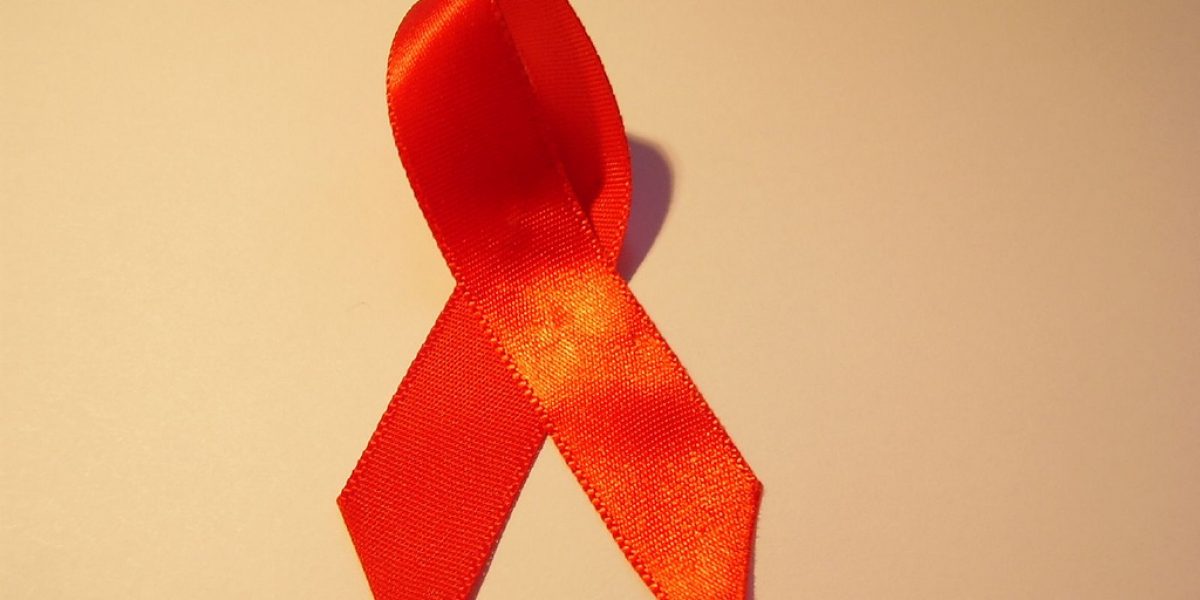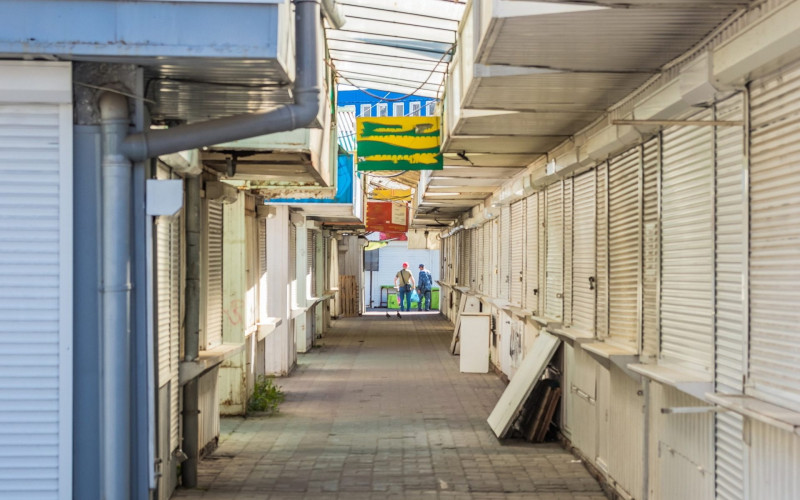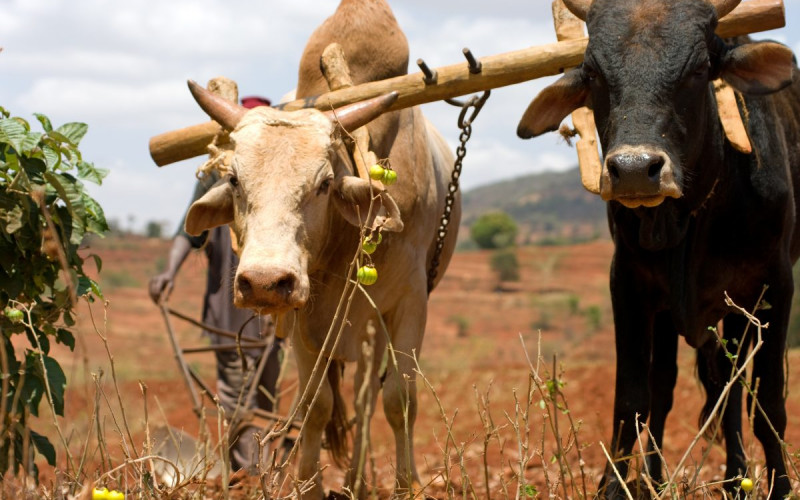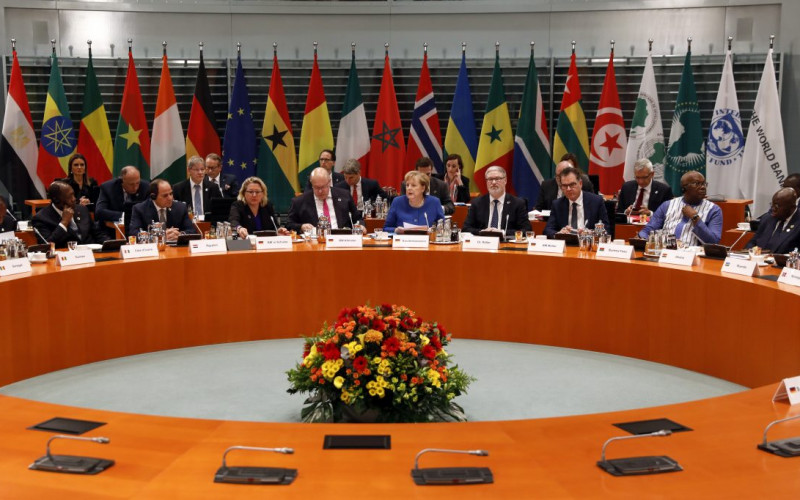‘Don’t worry,’ Dlamini assured the older woman, a stooped and wrinkled grandmother caring for two AIDS orphans and seven other relatives. ‘I will be here when it is time to harvest.’
Dlamini’s concern for Sihlongonyane is more than simply normal neighbourly compassion; it’s part of a concerted effort in Swaziland to renew a sense of community responsibility for social problems, especially the rising number of orphans, in the era of AIDS.
Both women are involved in a project dubbed indlunkhulu, meaning ‘the big house’. The programme is an attempt to revive an old tradition under which local chiefs kept fields – ploughed and harvested by their subjects – to provide for the community’s neediest. In its modern incarnation, the food will be earmarked for families with orphans and other vulnerable children.
‘The solution to HIV problems has to come from within the country,’ said Derrek von Wissel, director of Swaziland’s National Emergency Response Council on HIV/AIDS, which is coordinating the project. ‘We must exhaust our thinking and creativity before we start looking at other models. I’m not saying that one must not look at other models, but you mustn’t go and try in the first instance to go import some model that worked in San Francisco, because in all likelihood the cultural roots of that model may not fit.’
More than 12 million African children have lost at least one parent to AIDS. In Swaziland, a country of just more than a million, the UN estimates there are 70,000 orphans, up from 20,000 in the year 2000.
The vast majority of such children, perhaps as many as 95% according to the World Bank, are cared for not in institutions, but by relatives, usually by a surviving parent, aunts and uncles, grandparents or older siblings.
Enduring the strain
Yet the epidemic, most observers agree, is stretching these extended families to the breaking point. In the hardest hit communities, foster parents are themselves dying, and those that remain are struggling to cope. Already, some researchers have estimated that in many hard-hit countries, one in six households is fostering an orphaned child and most of those experience economic stress if not assisted.
And the problem is only expected to get worse in coming years. The number of orphans on the continent is expected to nearly triple in the next five years to more than 35 million, although improved access to antiretroviral drugs may slow or delay the speed of that rise.
In the face of such numbers, and given Africa’s limited resources, countries such as Swaziland must find low-cost, high-impact ways to support and protect orphans within their own communities.
‘I think almost everyone is agreed that institutions are not the way to go, everyone except maybe some large church-based, big time US fundraisers,’ said Alan Brody, UNICEF country director in Swaziland. ‘We all know the best result for orphaned children is to be taken into a warm and caring foster family. And that’s the tradition in Africa. There were no orphans. Every child was cared for. The problem is that at the moment, the decimation of families is so extensive that the extended family system is not working.’
‘The key issue,’ he said, ‘is how do you get resources to those families?’
Nowhere is the magnitude of Africa’s orphan problem, or the challenges it presents, more obvious than in Swaziland, now believed to have the world’s highest HIV-infection rate. The country’s last antenatal survey, in 2004, found that a staggering 42.6% of pregnant women were infected.
Many communities like Nsenga chieftaincy, where Sihlongonyane and Dlamini live, are already beginning to groan under the impact of AIDS and, as the epidemic matures, the number of AIDS-related deaths, and thus of orphans, is likely to continue to increase, despite the recent rollout of antiretroviral drugs at a handful of urban hospitals.
Society in Swaziland is unprepared to face the growing crisis. The department of social welfare only has 16 employees dedicated to welfare issues. There are no social welfare grants, as there are in South Africa, and no capacity to distribute them even if the money to pay for such a programme existed. So Swaziland is relying on low-cost, community-based programmes to address the growing orphan crisis.
Under government supervision, indlunkhulu builds on existing state infrastructure and Swaziland’s strong network of traditional leaders. Each of the country’s 360 chiefs was instructed to set aside land for an indlunkhulu field and oversee the planting, maintenance and harvesting of the crop. Each chieftaincy has a large, central field that will supply food to the area, but in some places like Nsenga, smaller fields have also been planted for individual families. Extension officers from the agriculture department offer advice and oversee the distribution of starter seeds and fertilizer. Eventually, government officials hope the programme will be sustainable, with the fields producing enough so the surplus can be sold to buy inputs for the next year.
Only two years old, the programme has so far had mixed success in feeding orphans, in part due to poor weather. In 2003, according to Von Wissel, 190 indlunkhulu fields were planted in the country’s about 360 chieftaincies. But because of poor rains, 40% of those failed completely and only 12% were able to produce enough food to feed all the orphans in the area.
It is still too early to tell how the 300 fields planted in 2004, which were harvested in May, fared. But Swazi officials are hoping for a better yield across the country, in part because this year they required communities in drought-stricken areas to plant crops that fare better than maize in drought conditions, like sorghum and sweet potatoes.
The impact of indlunkhulu and similar programmes, however, may extend beyond simply feeding hungry children. Government officials hope that by forcing communities to confront the AIDS problem, it will eventually help inspire them to do more.
‘It’s a common enemy and we must all gear up to fight it,’ said Martin Fakudze, the agricultural officer who volunteered to assist Nsenga on the indlunkhulu project. ‘That is what we are trying to show people.’
Sihlongonyane, whose own planting is limited by access to seeds and fertilizer, says the food from the indlunkhulu field will provide welcome relief. In Nsenga, unlike in other parts of the country, the harvest this season is expected to be good. But she and Dlamini also say attitudes towards AIDS, and the community response towards those affected, are beginning to change.
‘I am grateful that this tradition is coming back,’ Sihlongonyane said of indlunkhulu. ‘People are starting to help each other again. Even if you are terminally ill, people are coming to care for you and feed you.’
Of course, food security is only one of many problems orphans face. Orphans are often emotionally traumatised, lose access to education, and are more vulnerable to sexual and physical abuse. Indlunkhulu may help those families whose primary concern is lack of food, but it is not a panacea.
Two other orphan programmes in Swaziland, ensuring that children go to school and have community-based day care, demonstrate the potential of supported community-based responses and the limits of government programmes in weak states.
In 2003, the government set aside about $2.5 million for school fees for orphans. The first year, the programme was a disaster, government officials also admit.
With no systems in place to ensure that the money was distributed, it is unclear who the fund benefited and there have been widespread allegations that much of the money went to pay the school fees of children with connections rather than to the neediest orphans.
‘We don’t have a clear framework for the disbursement of resources,’ said Emmanuel Ndlangamandla, director of Swaziland’s Coordinating Assembly of Non-Governmental Organisations (CANGO). ‘And therefore, you may find at the end that we’re not really addressing the problems, because money is lost in-between. Government is spending, but money is not reaching the intended beneficiaries because there are no systems or systems are weak.’
In recent years, the amount of money dedicated to the programme has been expanded dramatically and the system for choosing who will benefit changed. In theory, all orphans in Swaziland should be receiving free education. Today the orphan fund is working better than when it started, but there are still many children who should be benefiting who have slipped through the cracks.
Twelve-year-old Thembinkosi Habile is one such child. The rail-thin, quiet orphan in ragged clothes lives with his grandmother in Mayaluka village and has never been to school. Swaziland’s orphan education fund is supposed to fund school fees for parentless children, but the local headmaster says his school’s quota of orphans has been filled.
Fortunately, Habile is being assisted by another programme, a UNICEF-sponsored project called Neighbourhood Care Points. NCPs are shoestring operations, run mostly by local women who volunteer to care for, feed and teach orphans and other vulnerable children basic skills. The caregivers also become informal social workers for the orphans: listening to problems at home and, when possible, advocating on their behalf.
Dudu Mabuza runs the Mayaluka care point with four other women, all grandmothers and most caring for orphans themselves. The project is run out of a community member’s spare room, which doubles as a classroom and storeroom, although a small building is being constructed for the children. There Habile has learnt to read the alphabet, count, and recite the days of the week and months, although sometimes he still gets confused.
From UNICEF, the care point has received some cooking pots and plates, some educational materials, and mats for the children to sit on. Because they are in a drought area, at the moment they receive food from the World Food Programme. Sometimes though, when that food runs out, they canvass the neighbourhood for donations. Eventually, the idea is to use food from the indlunkhulu. But the volunteers receive no salary or stipend.
‘We recognised that some kids were poor and had nothing to eat, so we volunteered to help them,’ said Mabuza, a plump, smiling woman who uses a ruler to keep time as she leads the children in song. ‘We’re expecting God to reward us in the end, but if something comes up to help, we would be grateful.’
So far, there are 300 UNICEF-sponsored care points around the country, but as the programme expands they have found that some local communities have been adopting the idea even without outside assistance. In one neighbouring village, Mabuza said, a local woman who had visited their programme began to take in and feed orphans in her own community. But a few weeks ago, she too died of AIDS.
As the programme grows, UNICEF is trying to figure out a way to support caregivers without destroying the sense of volunteerism and community-based nature of the project. It is, says Brody, a fine line. The trick, he says, is to build community ownership of the programme before flooding it with resources. Much of their job so far has been to simply spread the idea – which was initially conceived by a Swazi villager involved in a UNICEF study – of the extent of the orphan problem.
‘We started this on a very ad hoc basis, just encouraging them,’ he said. ‘All we were giving was a big cast iron pot and the communities were giving their own food.’ As more resources became available, they began to increase the assistance. But each NCP remains at root a community project.
In contrast, a NERCHA programme to build orphan support centres in each chieftaincy has so far floundered. The buildings have been built, but there is little happening inside them.
While even programmes like indlunkhulu and the NCPs may be subject to abuse, so far they seem to be running smoother than government-run programmes such as the orphan education fund. One reason for this may be their community-based nature, another that they are less resource-dependent and therefore there is less space for corruption: the total budget for the NCPs has been less than $2 million, most of which has gone to buy basic materials such as cooking pots and roofing. And finally, while the programmes are targeted primarily at orphans, other vulnerable children are not excluded, so there is less of a sense of favouritism within communities.
Swaziland’s experience offers lessons for Africa’s poorest countries, showing that effective orphan care programmes can be developed even in the absence of big budgets and sophisticated bureaucracies. But it may also provide models for richer African countries struggling to deal with growing orphan populations.
The governments of South Africa and Botswana, for example, have taken entirely different approaches to the problem, relying largely on the civil service and government bureaucracy to distribute resources to orphaned children and their foster families.
In South Africa, foster care-givers can apply to receive a Foster Child Grant of about $84 a month for each orphan they are caring for. In Botswana, orphaned children receive monthly food baskets from the government.
But such programmes often become tangled in bureaucracy and are subject to corruption. In South Africa, for example, the process of signing up for a grant is so onerous that few are able to access them without outside assistance.
In order to register for the grant, families must have birth certificates for the children and death certificates for the parents. They must submit an application to the Department of Welfare and receive an assessment visit by a social worker. Then they must appear before a magistrate to receive legal custody of the children.
Once all these steps are completed, the application often takes months or even years to be processed. Still, the government believes it loses about $225 million a year to fraudulent social grant claims.
Until the social grant system is fixed, perhaps more emphasis should be placed on helping communities help themselves.








